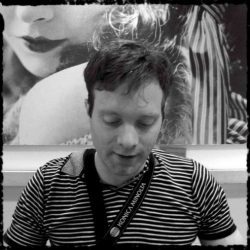
What can painting, and only painting, give us? Neither philosophy, psychology… nor any other kind of science is reaching so deep besides all forms of art.
What makes painting so special for the artist and the viewer?
The birth of color, tracing a line or contour, or filling a surface, is inseparable from a kind of birth. A starting point that brakes the silence of the blank canvas or paper. Many (very repetitve) analytical essays have been written about the “blank page” or “blank canvas”…
But it might be just all the contrary. Isn’t there actually an endless fullness, an enormous clutter of possibilities? (Like Leibniz’s abundance of possible worlds, from which “The Creator” has chosen the best possible). Painting can be the act of erasing, of eliminating things right now, maybe to let them out at a later point, maybe not. Maybe reframed, maybe acting as a counter-weight, or background to something else that appeared in the meantime. Painting can be a great way to remove the excessive, like overpainting graffities on a wall.
There is a need for “a disaster” or “a scream“, as a starting point of the act of painting teached philosopher Gilles Deleuze in his course “Sur la peinture” in the 60’s at the Sorbonne. A theme so nicely depicted in Edvard Munchs painting of the same name. He enumerates and develops the examples of William Turner, Cézanne and Van Gogh, Bacon, (and their “madness”?) The Deleuzian “disaster” belongs to the act of painting, but it takes place at a time when the picture is still to be painted. It is the pre-pictural work of the painter. A moment when the artists breathes the “virigintity of the world”… and of his canvas. The driving disaster is an absolute condition to the painter, according to Deleuze.
For Klee, as we can read in his painter’s diary, a disaster engendered the primordial “egg”, as a cosmogenesis of Painting. But, according to Klee, “the disaster cannot take it all”, otherwise nothing will come out of it. Painters do not stop failing, overpainting, reframing and even destroying their paintings, because they feel precisely if chaos (nothingness), the unwanted, took over (e.g. like a dirty grey that appears when colors were mixed too much or in a wrong way). then there is something that they have to undo or redo… or to put to the trash. Rembrandt was famous for this. Up to recent painters…
What is this threshold? Where lays the thin line between painting and nothingness that is intimately depending on the artists view and their specific historical surroundings, and what makes them so special for their times?
Cézanne, who read Kant, wanted to paint space and time so that they become shapes and colors. The colors and forms give large noumenal units (mental constructs), ideas and colors are noumenes inside the painters mind, not yet on the canvas.
And then, a tiny spark ignites the process, a kind of deliverance to a specific rule or intrinsic behaviour of the painted element, but also to the behaviour of the used technique. And then, it organizes itself through the eye and hand of the artist, giving a frame and a hold through every following step. Once birth was given, a new life starts. According to the used technique (for instance watercolor) there is then “a rise in color” that follows, like a crescendo, first the brighter than successively it gets to the darker. Also a crescendo of shapes. But at anytime the colors or forms can be swallowed again by the gloom, colors then turn into dirtyness, shapes into meaningless and unpenetrable chaos. A chaos that can not be even considered as a theme of itself. Dirty grey is painter’s enemy as well as nothingness. Some painters love to play close to this abyss and are pushing towards this edge.
Ready-made ideas must not necessary be ideas of others. They can be your own, your own ready-mades, so to say, but precisely therefore they must be overthrown, that is what pushes every time a painter when he starts a new work, extending his own horizon and the horizon of the viewer. At the beginning there is a continuity that has to be interrupted, the canvas and the mind is already overfilled with clichés. Then a new continuity has to arise into a new flow of paint. Erase, substract, remove, faire table rase – these are the very first steps, and it starts not on the canvas but already in the head of the innovative painter. In our era we are overfeeded and rapidly consuming all kind of pictures, never it has been such a struggle to clear the mind. But probably never it has been such a intimate joy to bring out something of your own, a mindscape, in the world of the omnipresent ready-made!

